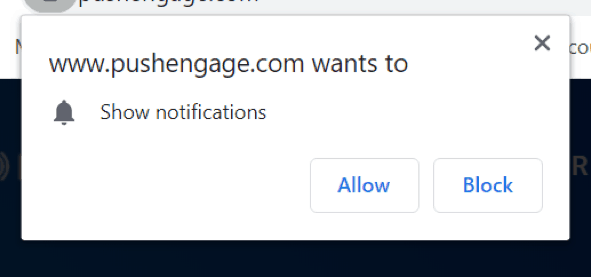Email is a saturated channel. You can pour your creative soul into crafting something beautiful and persuasive, only to find that just 8% of your database has opened it. So, if you are doing a promotion of your llc in california, with the wrong email marketing it could go to waste.
See this example that shows how removing email registration increased retention by 4.5%.
This is where web push notifications come in. They’re currently being offered by enough sites so as not to seem unusual or suspicious, but they’re not so popular that we as consumers are totally sick of them. And they’re thought to convert around four times better than emails, too.
We’re in the web notification glory days, but they won’t last forever. Plus, the technology is simple, and the notifications themselves are quick to make and send as well.
We’ll show you how to develop a comprehensive web push notification strategy, to ensure you’re using them to engage – rather than irritate – your audience.
Web push 101
First, let’s clarify exactly what web push notifications actually are.
Web push notifications are small messages from a website, which you can opt in to receive when prompted. They’re like notifications you’d get on your phone, popping up instead in the corner of your computer screen (which corner depends on your desktop OS).
The best part? Users become subscribers with just one click. No form to fill in, no need to hand over personal details, no redirects – they just have to hit the ‘Allow’ button when prompted:

The notifications themselves look something like this:

Click on the notification, and you’ll be taken to the set URL; click the little cross in the top corner, and it’ll be dismissed.
There are plenty of platforms out there that make adding web push notifications to your site a breeze and ensure you’re complying with data protection legislation as you do it. SendPulse and PushEngage are two popular options.
How to make web push notifications work for you
Once you’ve got the technology in place, it’s time to consider your approach. Catch-all newsletters may work for your email subscriber base, but sending the same thing to all your web push subscribers, and at the same time, will be a huge waste of this channel’s great potential. It’s time to think smart.
1. Consider when you ask for opt-in
Let’s imagine someone has come to your site from the SERP, most likely with no prior knowledge of your brand. The page has barely loaded, but suddenly – BAM! A prompt appears asking for their permission to receive notifications from you. Like a reflex, they’ll reach straight for that ‘Don’t Allow’ button – after all, they don’t know your brand, or your content, from Adam.
Try adding a delay of around 15 seconds to your opt-in prompt. By this point, the user will have a feel for your product or content, and your message will be far better received.
It’s also important that you don’t consider the opt-in message, or push notifications as a whole, in isolation.
The situation above would be made a lot worse if the same visitor was hit with an ‘Accept Cookies’ message, a mail list pop-up, and a paid ad all at the same time. That’s an extreme example, of course – but always make sure to test all pages while logged out of your site, and with a cleared cache, so you’re getting the true user experience. You want this to be as seamless as possible.
2. Set expectations when you ask visitors to opt-in
Your auto-generated opt-in prompt will read ‘[website domain name] wants to: show notifications’.
This is missing some key information that could make all the difference when trying to point users towards that coveted ‘Allow’ button:
- Can I change my mind if I opt-in?
- What do you want to notify me about?
And, if possible:
- How often will you be notifying me?
This is a lot of information to convey with a really concise amount of copy, but it’s worth taking the time to get it right.
Exactly how you tackle this depends on your brand’s tone of voice. We favor something casual, along the lines of ‘We’d love to send you notifications – only the good stuff, we promise! Opt-out any time.’
Or if you’re planning to send notifications to update customers on their orders, how about ‘Hey! Can we send you notifications about your order? Opt-out whenever!’
Both set expectations, without diving into the precise minutiae of what will be sent and when.
Note: Some territories require that you show the standard opt-in prompt after the customized one, in which case it’s worth testing whether the added trust benefit counteracts the added ‘effort’ of the double-opt-in.
3. Consider how you should send notifications
Now we’ve established how to get people to sign up to receive notifications, let’s cover what you should be sending them, and when.
There are three different approaches to sending notifications:
- A set message at a set time. These can be scheduled in advance or written and sent when needed.
- Trigger messages. This is when a certain action (e.g., viewing a product) triggers a message to be sent a certain amount of time after the event.
- Drip feeding a message sequence. Sending a predetermined sequence of content at predetermined intervals, either after opt-in or after a certain event.
That all sounds simple enough, but what if we told you that the best web push strategies would be using all three methods at once, all the while careful not to send too much to one visitor?
You see, each approach serves its own unique purpose:
Sending a set message at a set time is ideal for that hot off the press update, a sale launch, or the publication of a new article. You should still pay attention to where your audience is based, so they aren’t getting your notification in the middle of the night (something we’ll cover in more detail in the section below) – unless of course, you’re covering breaking news, which should be sent out as soon as possible.

Trigger messages work really well for eCommerce sites, helping to convert browsers into buyers. You can set up ‘abandoned cart notifications’ to check-in after visitors leave your site without checking out, or even follow up with a discount for a product they’ve viewed, or a notification for when a previously out of stock product comes back in stock. You can afford to go for the hard sell here, as you know their intent is high.
A drip-fed message sequence is ideal for welcoming new sign-ups to your brand through a carefully-optimized sequence of content. It’s perfect for visitors who sign up via top of funnel pages, such as blog posts. With a careful approach, you can guide them further down the funnel and eventually towards your most commercial ‘hero’ content, whatever that may look like for your site.
Working up to using all three strategies in tandem should be the ultimate aim, but isn’t realistic if you’re just starting out. If you’re an eCommerce site, work on your trigger notifications first – these should deliver some really quick wins. News sites should focus almost exclusively on those reactive notifications, while other sites should prioritize making a really great welcome sequence before experimenting with the other two approaches.
4. Make notifications personal
As you might expect, notifications work best when they speak to the person you’re sending them to. In fact, it can increase open rates by up to 800%.
In one sense, they should speak to them quite literally; it’s easy to set up your notifications to call your visitor by their name. This might sound creepy, but trust us – when used sparingly, it really works. Actually, don’t take our word for it – test it! (We’ll get to that a little later on).
In another sense, notifications should feel relevant to your audience. This is something you can – and should – look to achieve through segmentation, dividing your total database into smaller groups with the same characteristics and interests. In fact, when it comes to making a web push strategy that works, your approach should be to segment, segment, and segment again.
Depending on what tool you use to build your web push notifications, you’ll have access to the following information on each subscriber:
- The category they signed up within
- The landing page they signed up on
- Their age
- Their gender
- Their profession
- Their location
You can use the first four factors to segment users into groups who, broadly speaking, are likely to want to see the same content – and by the way, the more groups, the better.
To give a practical example, on our site, we write primarily about website builders, but also about how to build a website using WordPress. Both are valid routes to getting online, but they’re very distinct – we segment users by the category in which they signed up to avoid sending them content that won’t be relevant to them, or which could even be confusing.
The final two factors, profession, and location are helpful for further segmenting these groups to determine what time you should send to them (for drip-fed or scheduled messages). There’s no point in nailing tailored content, only to send it at a time the intended recipient is unlikely to be at their computer – or even awake.
5. Write persuasively
You’ve persuaded people to sign up for your notifications, and you’ve set everything up for a totally tailored experience.
But neglecting your copy could mean the effort you’ve put in so far is all for nothing. If you don’t give your users a compelling reason to click your notifications, then they won’t – it’s that simple.

You’ve only got a really small amount of text to play with, and it should stay that way – don’t fall into the trap of writing a small essay, even if there’s space to do so. However, there are some simple steps you can take to inspire action:
- Write simply. Use short words and the most approachable language possible.
- Cut any unnecessary words. Adverbs and adjectives have no place in a web push notification!
- Get creative. If you’re promoting an article, for example, try drawing out a compelling fact or stat that will pique interest.
- Front-load your sentences. Don’t bury the important stuff – if you’re promoting a sale, lead with the sale!
- Use verbs that inspire action. Claim, read, check out, buy, visit, etc.
- Don’t stick to just words! If it fits your brand image, throw some emojis into the mix.
6. Test and optimize
So now you’ve got a beautifully segmented database, receiving a nice, regular installment of your persuasively written notifications.
It can be tempting at this point to think that your work here is done. Unfortunately, it’s really only just begun – now it’s time for the testing and optimizing to begin.
Most push notification tools will let you run what’s known as an AB test on your notifications. This allows you to show two different versions of the same notification to a 50/50 split audience. This is such a powerful tool, as it gives you immediate, actionable insights into what works best. You’ll be amazed at the difference just changing one word could make.
With this in mind, make sure you always follow the golden rule of AB testing: only make one change at a time. Otherwise, it’s impossible to isolate the cause of the impact! Here’s an example of a good test:
Version 1: Use the code ‘FREENOW’ to claim free delivery on your order. Version 2: Hannah, you have items waiting in your cart! Use the code ‘X1GHAF’ to claim free delivery on your order.
Hannah, you have items waiting in your cart!
In this case, we’re testing the impact of using a ‘memorable’ offer code versus a seemingly random one, which might look more legitimate.
Other than testing adjustments to the copy or proposition of your notifications, you should also look to test the best time to send them. Should you send an abandoned cart notification 10 minutes after the customer leaves the site or 20 minutes after? Do you get a better open rate when you send notifications at 4 pm, or just after lunch?
These are the kinds of questions you should be thinking about. As your database grows and you continue to experiment, you’ll gradually build a much clearer picture of what works for your site.
Final thoughts
Web push notifications are an exciting new channel for businesses of all kinds to explore. The effort to impact ratio paints a positive picture, and it can serve a wide range of goals – whether you want more sales, more eyes on your content, or just to grow brand awareness.
To get the most out of your web push notifications, be sure to follow our advice on building a successful strategy, paying the most attention to the final point: keep testing and optimizing! We can advise you on best practice, but this is ultimately the only way to build a strategy that will definitely work for your site.